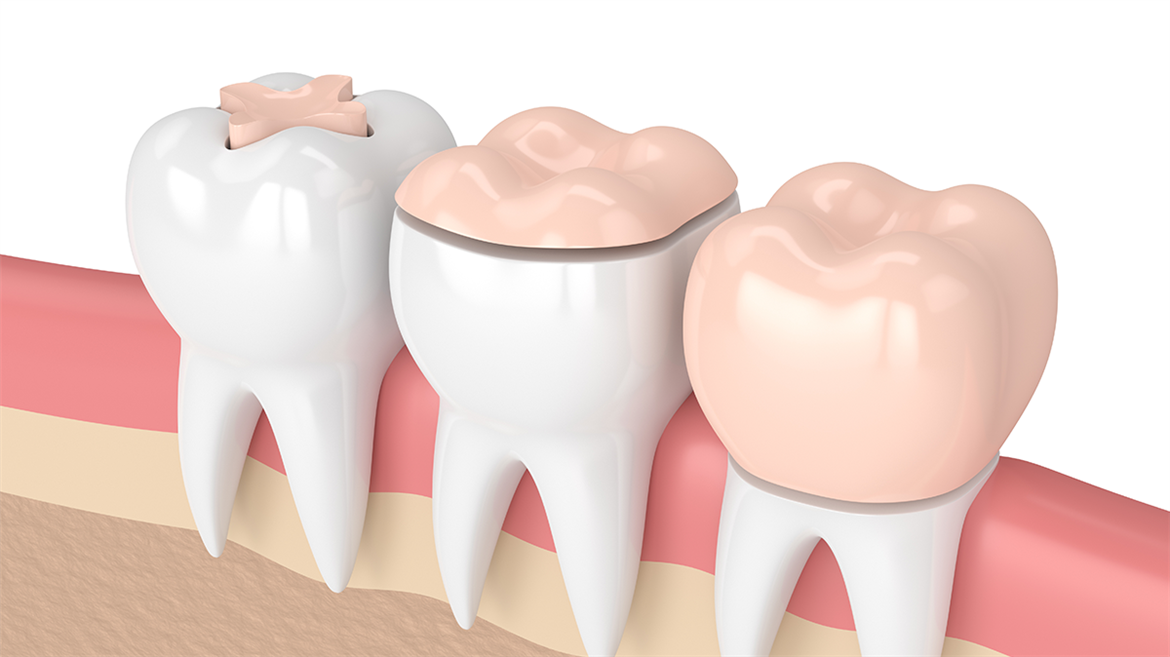İnlays & Onlays Crown

What are Inlay Onlay Crowns?
Inlays and onlays are types of dental restorations used to repair damage to teeth. An inlay is a filling specially made to repair damage to the surface of the tooth. It is made of materials such as porcelain, gold or composite resin and is designed to fit the shape of the tooth.
An onlay is actually quite similar to an inla, but it covers a larger area of the tooth and extends to the corners of the tooth. Both inlays and onlays are made by the dentist in a dental laboratory using CAD-CAM technology and adhered to the tooth with a strong adhesive. They are known as a strong, durable and natural-looking option for patients' damaged teeth.
Crown is also a dental practice and is used to repair fractures or breaks in teeth. A crown is a type of dental restoration that is attached to the upper part of the tooth to protect and strengthen the tooth. Crowns can be made of porcelain, composite resin or gold and preserve the natural appearance of the tooth. They are applied by the dentist by sticking them to the patient's teeth. They restore the natural strength of the tooth and protect the tooth for a long time.
A crown is a more extensive procedure that completely covers the tooth from the gum line to the crown of the tooth. They are mainly preferred when faced with teeth that are severely damaged or have a large filling and therefore cannot be treated with an inlay or onlay.
Crowns and inlays/onlays can last for many years depending on many factors, but exactly how long they will last depends on the type of material used and how the crown or onlay is cared for. In general, crowns and onlays made of porcelain and ceramic can last for 10 to 15 years or more, while those based on gold or other metals can last for 20 years or more. It is important to practice good oral hygiene and visit the dentist regularly to keep the crown or onlay in good condition as long as possible.
Key Differences Between Inlay, Onlay and Crown
The main difference between crowns and inlays/onlays is their degree of coating and protection. An important advantage of the crown is that it provides complete protection for damaged teeth. Because it covers the entire tooth, it can help prevent further damage and even improve tooth function. In addition, crowns can be made from a variety of materials, including porcelain, gold, or a combination of both, allowing them to match the color of the surrounding teeth and give them a natural appearance.
On the other hand, an onlay is a less invasive procedure than a crown and for some patients it is a serious choice. In addition, they require less preparation of the tooth as they do not cover the entire tooth and may be a more pragmatic and conservative option to quickly repair the damage. Also, veneers are typically made of tooth-colored materials, which often makes them less noticeable than crowns.
In summary, the patient's decision between a crown and an onlay primarily depends on the extent of the damage to the tooth and the preference as a result of consultation with the dentist. While the crown seems to be a better option for oral health, onlay may be a more aesthetic choice for some patients.
However, a number of variables may pose a threat to the long-term durability of inlays, onlays and crowns, such as:
- clenching teeth,
- chewing nails,
- chewing on hard or sticky objects
- Injury to the tooth or surrounding area.
These can cause the applied material to splinter, crack or splinter. In this case, an immediate repair or replacement may be required.
How is the Dental Crown Procedure?
A dental crown is a veneer that the dentist usually makes on top of a tooth. It is performed using local anesthesia. This process makes the teeth stronger and longer lasting and prevents tooth decay. In the dental crown procedure, the dentist first cleans the surface of the tooth and removes all caries. It then takes a precise model of the tooth by measuring it. Thus, the dental crown adheres tightly to the surface of the tooth, ensuring that the tooth remains durable and healthy.
What is the procedure for onlays?
At the first appointment in the onlay procedure, the dentist anesthetizes the mouth with local anesthetic so that the patient can feel comfortable before the tooth decay and damaged part of the tooth are removed. The dentist produces an impression of the tooth with a special paste and sends it to the laboratory where the permanent veneer will be produced. Then the tooth is covered with a temporary onlay. At the second visit, the dentist removes the temporary onlay and checks the fit of the permanent one. If the permanent fits well, the dentist will re-anesthetize the patient's mouth and permanently glue the onlay to the tooth.
Conclusion
Any dental caries may seem insignificant at first, but if left untreated, it can worsen and threaten the patient's tooth. This can lead to the loss of the tooth. To protect the teeth, it is very important to brush daily and use dental floss. It is also extremely beneficial to have a regular dental examination every 6 months. Also, if a patient experiences pain or discomfort between dental visits or after a dental procedure, they should consult a dentist immediately.

